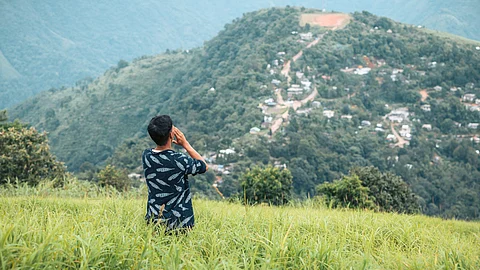
- HOMEGROWN WORLD
- #HGCREATORS
- #HGEXPLORE
- #HGVOICES
- #HGSHOP
- CAREERS
- ABOUT US
- CONTACT US

Tucked away in the East Khasi Hills of Meghalaya, Kongthong stands apart from the rest of the world. Here, in this remote village surrounded by deep valleys and towering ridges, a name is more than just a word — it’s a melody. This unique tradition, known as jingrwai iawbei, has been practised for centuries. Every child born in Kongthong is given not only an official name but also a tune, composed by their mother, which becomes their lifelong identity.
The melodies are deeply personal. A mother, upon the birth of her child, composes a song that is unique to them, a spontaneous expression of love. This tune becomes the primary way to address the child in daily life. Unlike spoken names, these melodies are never reused. When a person passes away, their song dies with them, making it an irreplaceable part of their identity.
Jingrwai iawbei translates to 'a song in honour of the root ancestress', reflecting the matrilineal traditions of the Khasi people, who dominate the region. In this society, lineage is traced through mothers, and the tradition of giving musical names is seen as a way to honour maternal bonds and ancestral roots.
The melodies serve both cultural and practical purposes. Longer versions of the tunes, lasting up to 20 seconds, are used to call out across the hills and forests. In the past, these melodies helped residents stay connected while working in the fields or foraging in the forests. Shorter versions, resembling nicknames, are used in closer settings, such as at home or within earshot.
The Khasi also believe that the tunes provide protection. In local folklore, spirits residing in the forests cannot distinguish the melodies from natural sounds, making it safer to call one another without drawing unwanted attention.
Like many ancient practices, jingrwai iawbei faces challenges in the modern world. Younger generations are leaving Kongthong in search of education and work in cities, and with their departure, the tradition risks being forgotten. The filmmaker Oinam Doren explored this in his documentary My Name is Eeooow, which highlights how oral traditions like this can vanish without active efforts to preserve them.
Infrastructure developments, such as the construction of a road in 2014, have brought Kongthong closer to the outside world. Tourism is now emerging as a way to sustain the village and its culture. In recent years, the village has attracted visitors drawn to its unique way of life. In 2021, Kongthong was even nominated for the UNWTO’s Best Tourism Village award, recognising its efforts to balance tradition with modern needs.
However, this growing exposure comes with risks. The melodies, once deeply rooted in the rhythms of daily life, are beginning to change. Some mothers now draw inspiration from popular songs, a shift that raises questions about how much of the tradition can adapt without losing its essence.
Kongthong’s melodies are more than a cultural curiosity — they are a way of life. They represent a connection to the past, a sense of belonging, and a deep respect for the bond between mother and child. But as the village opens up to the outside world, the question remains: can this fragile tradition survive modern pressures?
The community itself is divided. Some, like community leader Rothell Khongsit, have returned to Kongthong to promote its culture and tourism. Others see migration and modernisation as inevitable. While tourism offers a way to share jingrwai iawbei with the world, it also risks turning a living tradition into a mere attraction.
For now, the songs of Kongthong continue to fill the air, carrying with them stories of a community that has thrived on its own terms. Whether these melodies will endure or fade into memory depends not only on its practitioners but also on how the wider world engages with them — as an exotic spectacle or as a tradition worth protecting.
In Kongthong, identity is not spoken; it is sung. And for now, those songs still echo across the hills.
